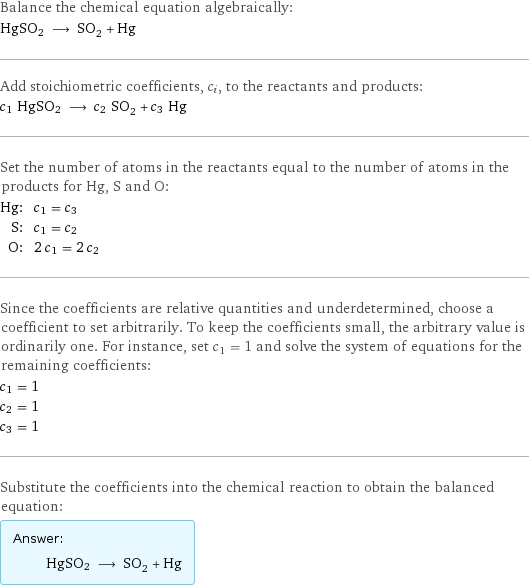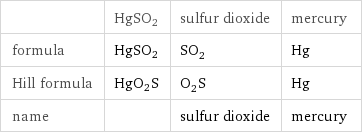Input interpretation

HgSO2 ⟶ SO_2 sulfur dioxide + Hg mercury
Balanced equation

Balance the chemical equation algebraically: HgSO2 ⟶ SO_2 + Hg Add stoichiometric coefficients, c_i, to the reactants and products: c_1 HgSO2 ⟶ c_2 SO_2 + c_3 Hg Set the number of atoms in the reactants equal to the number of atoms in the products for Hg, S and O: Hg: | c_1 = c_3 S: | c_1 = c_2 O: | 2 c_1 = 2 c_2 Since the coefficients are relative quantities and underdetermined, choose a coefficient to set arbitrarily. To keep the coefficients small, the arbitrary value is ordinarily one. For instance, set c_1 = 1 and solve the system of equations for the remaining coefficients: c_1 = 1 c_2 = 1 c_3 = 1 Substitute the coefficients into the chemical reaction to obtain the balanced equation: Answer: | | HgSO2 ⟶ SO_2 + Hg
Structures

HgSO2 ⟶ +
Names

HgSO2 ⟶ sulfur dioxide + mercury
Equilibrium constant
![Construct the equilibrium constant, K, expression for: HgSO2 ⟶ SO_2 + Hg Plan: • Balance the chemical equation. • Determine the stoichiometric numbers. • Assemble the activity expression for each chemical species. • Use the activity expressions to build the equilibrium constant expression. Write the balanced chemical equation: HgSO2 ⟶ SO_2 + Hg Assign stoichiometric numbers, ν_i, using the stoichiometric coefficients, c_i, from the balanced chemical equation in the following manner: ν_i = -c_i for reactants and ν_i = c_i for products: chemical species | c_i | ν_i HgSO2 | 1 | -1 SO_2 | 1 | 1 Hg | 1 | 1 Assemble the activity expressions accounting for the state of matter and ν_i: chemical species | c_i | ν_i | activity expression HgSO2 | 1 | -1 | ([HgSO2])^(-1) SO_2 | 1 | 1 | [SO2] Hg | 1 | 1 | [Hg] The equilibrium constant symbol in the concentration basis is: K_c Mulitply the activity expressions to arrive at the K_c expression: Answer: | | K_c = ([HgSO2])^(-1) [SO2] [Hg] = ([SO2] [Hg])/([HgSO2])](../image_source/bd0d0a3cc9217a27c014d61aef45b227.png)
Construct the equilibrium constant, K, expression for: HgSO2 ⟶ SO_2 + Hg Plan: • Balance the chemical equation. • Determine the stoichiometric numbers. • Assemble the activity expression for each chemical species. • Use the activity expressions to build the equilibrium constant expression. Write the balanced chemical equation: HgSO2 ⟶ SO_2 + Hg Assign stoichiometric numbers, ν_i, using the stoichiometric coefficients, c_i, from the balanced chemical equation in the following manner: ν_i = -c_i for reactants and ν_i = c_i for products: chemical species | c_i | ν_i HgSO2 | 1 | -1 SO_2 | 1 | 1 Hg | 1 | 1 Assemble the activity expressions accounting for the state of matter and ν_i: chemical species | c_i | ν_i | activity expression HgSO2 | 1 | -1 | ([HgSO2])^(-1) SO_2 | 1 | 1 | [SO2] Hg | 1 | 1 | [Hg] The equilibrium constant symbol in the concentration basis is: K_c Mulitply the activity expressions to arrive at the K_c expression: Answer: | | K_c = ([HgSO2])^(-1) [SO2] [Hg] = ([SO2] [Hg])/([HgSO2])
Rate of reaction
![Construct the rate of reaction expression for: HgSO2 ⟶ SO_2 + Hg Plan: • Balance the chemical equation. • Determine the stoichiometric numbers. • Assemble the rate term for each chemical species. • Write the rate of reaction expression. Write the balanced chemical equation: HgSO2 ⟶ SO_2 + Hg Assign stoichiometric numbers, ν_i, using the stoichiometric coefficients, c_i, from the balanced chemical equation in the following manner: ν_i = -c_i for reactants and ν_i = c_i for products: chemical species | c_i | ν_i HgSO2 | 1 | -1 SO_2 | 1 | 1 Hg | 1 | 1 The rate term for each chemical species, B_i, is 1/ν_i(Δ[B_i])/(Δt) where [B_i] is the amount concentration and t is time: chemical species | c_i | ν_i | rate term HgSO2 | 1 | -1 | -(Δ[HgSO2])/(Δt) SO_2 | 1 | 1 | (Δ[SO2])/(Δt) Hg | 1 | 1 | (Δ[Hg])/(Δt) (for infinitesimal rate of change, replace Δ with d) Set the rate terms equal to each other to arrive at the rate expression: Answer: | | rate = -(Δ[HgSO2])/(Δt) = (Δ[SO2])/(Δt) = (Δ[Hg])/(Δt) (assuming constant volume and no accumulation of intermediates or side products)](../image_source/4bcdc765cd2fe1c935e22419475d459b.png)
Construct the rate of reaction expression for: HgSO2 ⟶ SO_2 + Hg Plan: • Balance the chemical equation. • Determine the stoichiometric numbers. • Assemble the rate term for each chemical species. • Write the rate of reaction expression. Write the balanced chemical equation: HgSO2 ⟶ SO_2 + Hg Assign stoichiometric numbers, ν_i, using the stoichiometric coefficients, c_i, from the balanced chemical equation in the following manner: ν_i = -c_i for reactants and ν_i = c_i for products: chemical species | c_i | ν_i HgSO2 | 1 | -1 SO_2 | 1 | 1 Hg | 1 | 1 The rate term for each chemical species, B_i, is 1/ν_i(Δ[B_i])/(Δt) where [B_i] is the amount concentration and t is time: chemical species | c_i | ν_i | rate term HgSO2 | 1 | -1 | -(Δ[HgSO2])/(Δt) SO_2 | 1 | 1 | (Δ[SO2])/(Δt) Hg | 1 | 1 | (Δ[Hg])/(Δt) (for infinitesimal rate of change, replace Δ with d) Set the rate terms equal to each other to arrive at the rate expression: Answer: | | rate = -(Δ[HgSO2])/(Δt) = (Δ[SO2])/(Δt) = (Δ[Hg])/(Δt) (assuming constant volume and no accumulation of intermediates or side products)
Chemical names and formulas

| HgSO2 | sulfur dioxide | mercury formula | HgSO2 | SO_2 | Hg Hill formula | HgO2S | O_2S | Hg name | | sulfur dioxide | mercury
Substance properties

| HgSO2 | sulfur dioxide | mercury molar mass | 264.65 g/mol | 64.06 g/mol | 200.592 g/mol phase | | gas (at STP) | liquid (at STP) melting point | | -73 °C | -38.87 °C boiling point | | -10 °C | 356.6 °C density | | 0.002619 g/cm^3 (at 25 °C) | 13.534 g/cm^3 solubility in water | | | slightly soluble surface tension | | 0.02859 N/m | 0.47 N/m dynamic viscosity | | 1.282×10^-5 Pa s (at 25 °C) | 0.001526 Pa s (at 25 °C) odor | | | odorless
Units
